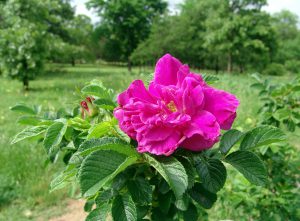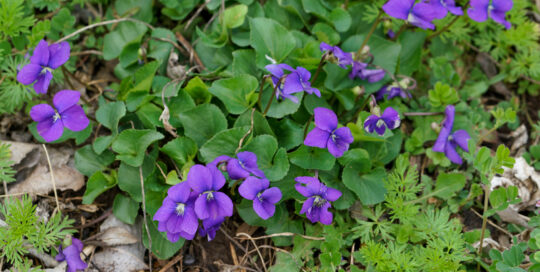Rugosa Roses: A Plant for Salty Places
Views: 6403

This blog entry will be a little ramble-y, but hopefully I’ll be able to tie it all up in the end, and even relate it to wildlife. So stick with me…
In high school, I was an exchange student to Denmark. I lived with a Danish family for a year, and the street where they lived ended in a fjord. (This is not as romantic as it may sound at first, because, while “fjord” often conjures the vision of spectacular mountains dropping dramatically into the ocean, Denmark is more like a giant sandbank between the North Sea and the Baltic. So, no mountains, no cliffs, just gently sloping, sandy beaches.) This particular fjord was lined with wild rose bushes. I fell in love with those roses because the beaches were flushed with brilliant pink while they were blooming in spring.
Skip forward in time a few decades, and I finally learned those roses’ name: rugosa roses, or Rosa rugosa, if you prefer the scientific name. Rugosa roses are not native to the U.S. or Europe. Many places consider them weeds or noxious weeds (including in many U.S. states), or even invasive (for example, along the coast of Denmark). They are native to Asia, found along the coasts of Japan, Korea, and China. But coastal areas anywhere are difficult places to survive, and rugosa roses are, indeed, quite hardy. They not only tolerate sandy soil, but salt, as well.
Current Day
I have two rugosa roses in my yard, and both have survived terrible drought, months of 100+ temperatures, freezing rain, wind, hail, and poor soil. (This will be a common refrain in my blog, I’m afraid: “It survives!”) I planted one in shade and still manages to bloom. They do not seem to suffer from black spot or rose rust. I have a love/hate relationship with non-natives, but there are times when simple survival and maintenance-free beauty is enough to win me over, and rugosa roses fall on the “win” side.
I’ve been thinking about rugosas this week for two reasons: First, we put out mineral (salt) licks for our deer. (Yes, I know many of you are wondering if we are crazy: You want deer in your yard? And you’re a gardener? But, yes, we enjoy our deer, and we even feed them corn and provide them with mineral licks.) But the mineral licks leave salty areas where very few plants will grow. One such place is in a spot that I want to develop now, and I am considering trying a rugosa rose there this spring, because of their salt tolerance. The second reason was this week’s ice storm. If you have salty areas in your yard, perhaps from road salt spread for winter road maintenance, you might consider rugosa roses. Just be cognizant that they may be invasive in coastal areas.
Pollinators
Now for the tie to wildlife: While rugosa roses aren’t natives, they do benefit pollinators, and many varieties produce abundant rose hips. Many birds love these rose hips, including Cedar Waxwings. I leave the rose hips on my plants rather than use them for jellies and jams, and they are always gone by Christmas. Another benefit is that you don’t have to use any pesticides or fertilizers to keep the plants healthy.
For more information about rugosa roses, including care and landscape uses, I recommend this article.
Meet Leslie Miller
Leslie Ann Miller shares 3.5 acres in rural Oklahoma with birds, butterflies and wide variety of animals. She is currently transforming her yard with plantings…
Leslie's Recent Posts

Early spring is time to plant native spring ephemerals






